There is nothing quite like growing tomatoes. Whether it is from seed or from a start, growing your own tomatoes is a rewarding experience. Once you harvest and taste your first tomato, you will be hooked. At least that is how it started for me. I am willing to bet, it will happen to you too.
Tomatoes are my favorite thing to grow in the garden. That comes from my love of all things tomatoes and the sheer fascination in the many different varieties there are to grow. Did you know there are black, purple, pink and even white tomatoes? How cool is that! Those tomatoes are most likely not in your local grocery store and if they are, I am almost certain they will not taste as good as home grown.
Through my years of gardening, I have learned quite a few things about growing this wonderful fruit and I am so happy to be able to share that knowledge with you. So, pull up a chair, grab a notebook and get ready to start growing tomatoes.
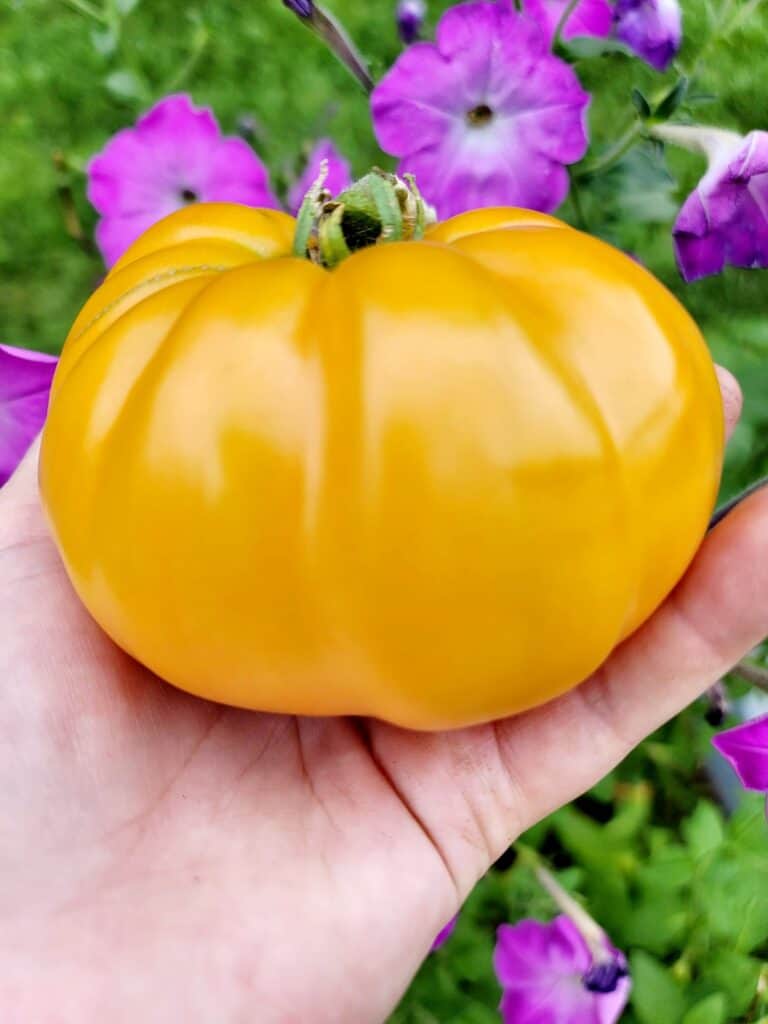
- Indeterminate and Determinate
- Planting Tomatoes
- When to Plant
- Where to Plant
- How to Plant
- Caring for Tomato Plants
- Supporting Plants
- Pruning Plants
- Pruning Indeterminate Tomato Plants
- Watering Tomato Plants
- Fertilizing Tomato Plants
- When to Harvest Tomatoes
- Follow Simply Scratch Made on Pinterest.
- Like this post?
- Leave a review below, I would love to hear your thoughts! ⭐⭐⭐⭐⭐
Indeterminate and Determinate
Tomatoes come in different varieties and types like, slicers, cherry and pastes. The two main types of tomatoes are Indeterminate and Determinate. When growing tomatoes, it is important to know which type of tomatoes you want to grow and to know the types.
Indeterminate
Indeterminate type tomatoes, also known as vining tomatoes, continually grow and set fruit until they die. Which is usually from sickness or a frost. These types of tomatoes need to be supported by a trellis to grow successfully.
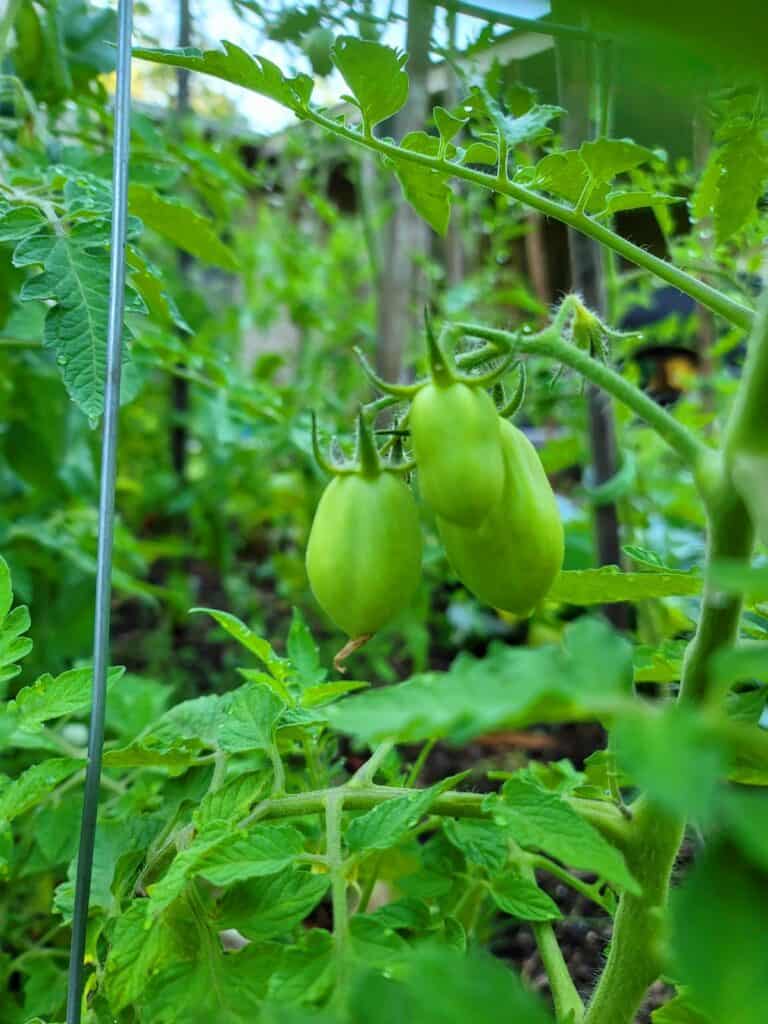
When left to vine across the ground they are more susceptible to disease and insect/animal damage. They can grow to 10 feet or even higher if you have a long growing season and the conditions are right. Which means a lot of fruit! I grow mostly indeterminate tomatoes in my garden.
A few of my favorite types of indeterminate tomatoes to grow are, Dr. Wyche’s Yellow Tomato, Big Rainbow, True Black Brandywine and Barry’s Crazy Cherry.
Determinate
Determinate type tomatoes, also known as bush tomatoes, grow to a predetermined size, and only produce a certain amount of fruit. These plants will stop fruiting after the top buds have set fruit and ripened.
While Indeterminate type tomatoes will continue to grow and set fruit, Determinate types only produce fruit in a short amount of time before they stop producing. This is usually about 1 month. This is the tomato type that you typically see tomato cages on. Trellis systems are not necessary for determinate plants, but they still need support from cages.
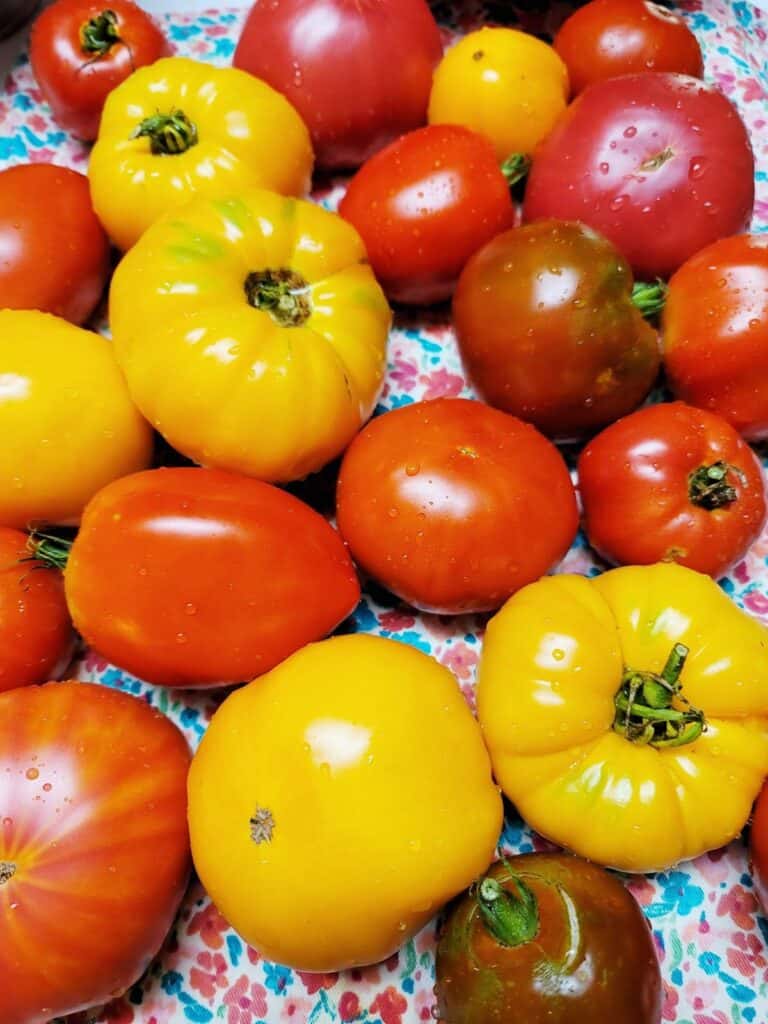
A few types of determinate tomatoes are, Roma, Celebrity and Better Bush.
Planting Tomatoes
When to Plant
Always wait to plant your tomato plants after your last frost. You can search your areas last expected frost date to get an idea of when to plant your tomatoes. I like to use The Farmer’s Almanac. This is just an estimation based on previous years. Always track the weather and don’t plant until the chance of frost has passed.
For me, I am in Zone 8b, my last expected frost date has been March 24th for several years. Most years this is true, but there have been a few years where we have had frosts into early April.
Tomatoes like warmer weather so it is best to wait until the soil temperature is at least 60° F before planting. Planting too early can stress your plants and potentially kill them.
Where to Plant
Tomato plants need to be planted in a well-draining sunny area. For the best growth and production plant your tomatoes in an area where they will receive 6-8 hours of direct sunlight.
How to Plant
Tomatoes need quite a bit of room to grow. Plants thrive when given enough room for healthy root development and airflow. When planted too close plants are more susceptible to diseases like blight. Overcrowded plants will compete for nutrients in the soil. When given enough room the roots will not need to compete for nutrients. I find that 12-18-inches all the way around each plant is perfect for my trellis/staking system.
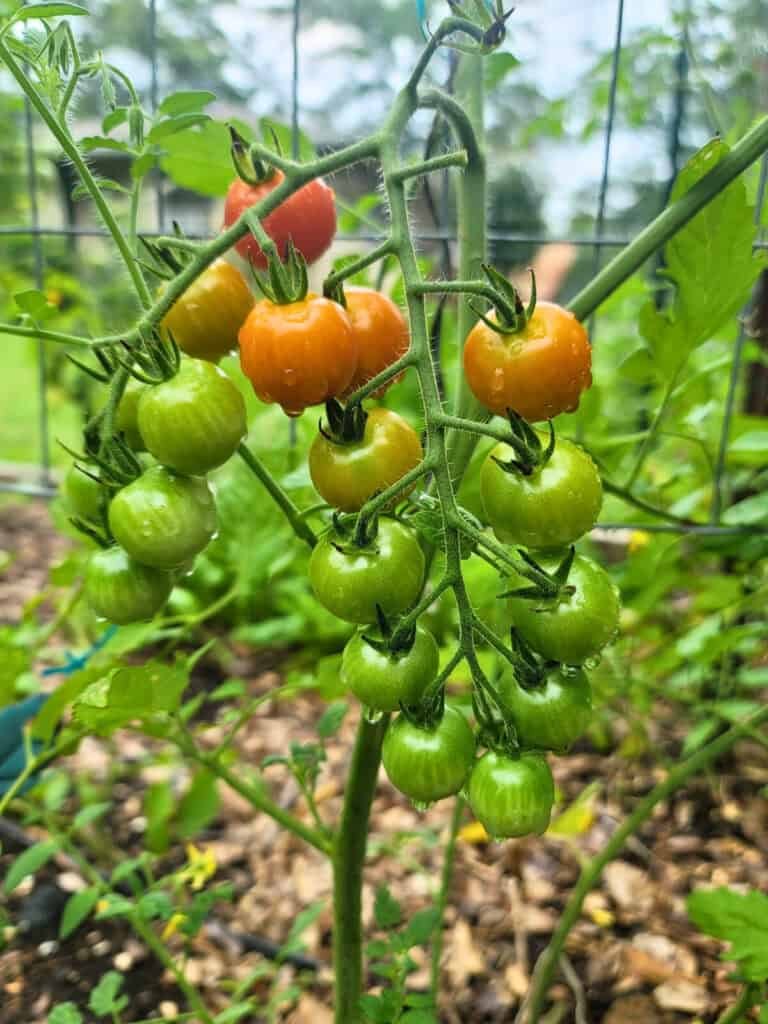
When planting in the ground try to plant the tomato plant deep. Tomato plants will grow roots from any spot on their stem that touches the ground. When you plant them deep, they are able to set out more roots. Which makes a sturdier plant.
I like to pinch leaves off of the bottom of the plant and dig my hole deep enough to plant the plant several inches deeper than the pot it was in. Also note that is important that none of the bottom leaves are touching the soil.
Caring for Tomato Plants
Supporting Plants
Tomato plants are prone to disease and need support to help them stay healthy. Two of the best things you can do for your plants are increase the airflow and get the leaves up off of the ground. Using tomato cages, stakes and trellises are all ways to support your tomato plants to get them off of the ground. This will help with airflow and keep the soil, which contains fungus, off of the plants. Healthy plants equal happy plants.

Pruning Plants
Pruning your plants also helps with airflow and is beneficial in healthy growth. By pruning the bottom branches, you are increasing airflow around your tomato plant. Remember airflow is a tomato plants friend. You want to make sure none of the leaves are touching the ground or are close enough to have splash back from water hitting the soil. It may seem wrong to cut branches off, but this is necessary in caring for your plant.
Pruning Indeterminate Tomato Plants
Indeterminate tomato plants require a little more pruning than determinate tomato plants. Since indeterminate plants will continuously grow and set fruit it is important to prune to a single stem. To do this you will need to prune the suckers from your plants. Too many suckers will cause your plants to take up a lot of space and reduce airflow.
A “sucker”, if left on the plant, will grow, branch out and produce fruit. This takes a lot of energy from the rest of the plant. So, it is best to prune off the suckers to allow the plant to focus its energy to the fruit it is producing on the main stem.
Learning how to identify a sucker is very important. A sucker grows in between the main stem and a branch. I like to call it the “armpit”. It will look like a tiny leaf growing in between the main stem and a branch.
DO NOT prune the suckers off of your determinate plants! Since they will only produce a determinate amount of fruit, pruning the suckers will decrease your yield.

Watering Tomato Plants
Always water around the roots of your tomato plant. Avoid watering from the top and never use a sprinkler. This helps reduce the chance of disease. Drip tape, soaker hoses or watering with your watering can/water hose are the best ways to water your tomato plants.
Knowing when to water is also important. Tomato plants are grown in hot weather and require a lot of water for production. To check if your plant needs water simply test the soil for moisture. Feel the top 1-inch of soil, if the soil is moist don’t water. If it is dry, give the plant a deep watering.
Plants benefit more from deep watering than they do from shallow watering. Deep watering encourages the roots to grow down in search of nutrients instead of close to the surface.
Fertilizing Tomato Plants
Tomato plants are heavy feeders and grow best in rich nutrient dense soil. Using fertilizer can help keep the plants healthy as they grow. I like to amend my soil with fresh compost every year. That is what I rely on the most for adding nutrients to my soil.
Another step I take is adding eggshells, bone meal, blood meal and worm castings to the hole when I plant my tomato plants. Throughout the growing season I will mix together fish emulsion and water and fertilize my gardens.
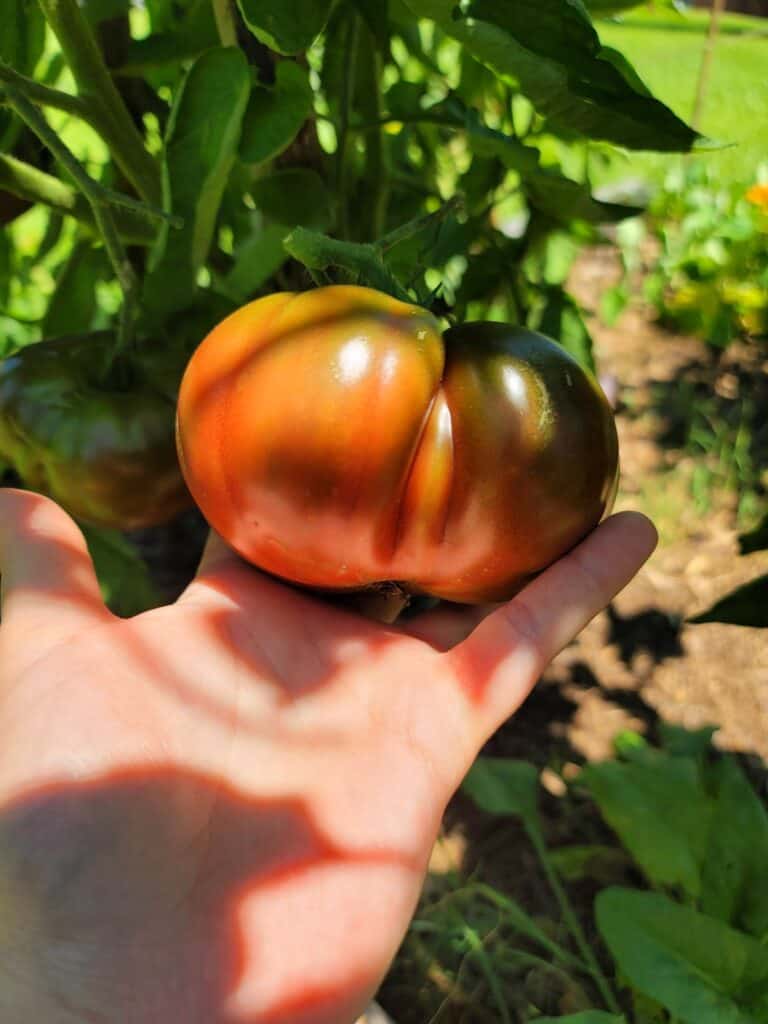
These are all natural fertilizers that you can use to add nutrients to your soil. The only other time I use fertilizer is when I see my plants need it. But for the most part, healthy soil is all the plant needs to thrive. Before fertilizing it is recommended to have your soil checked. This will help provide you with the information needed to properly amend your soil.
When to Harvest Tomatoes
The best part! Nothing is more exciting than getting to harvest and eat your first tomato of the season. When do you harvest it and how do you know it is ready? First, you can look at the color. Is it the color that particular variety should be when ripe? Second, feel it. Gently squeeze the tomato. If it is still hard, let it go another day then check again. When ripe, a tomato will give slightly.
Unripe tomatoes that have started to blush can be harvested and left to ripen on a countertop or windowsill. Do not refrigerate unripe tomatoes, they will not ripen.
I hope this post on Growing Tomatoes was helpful! Happy Gardening!
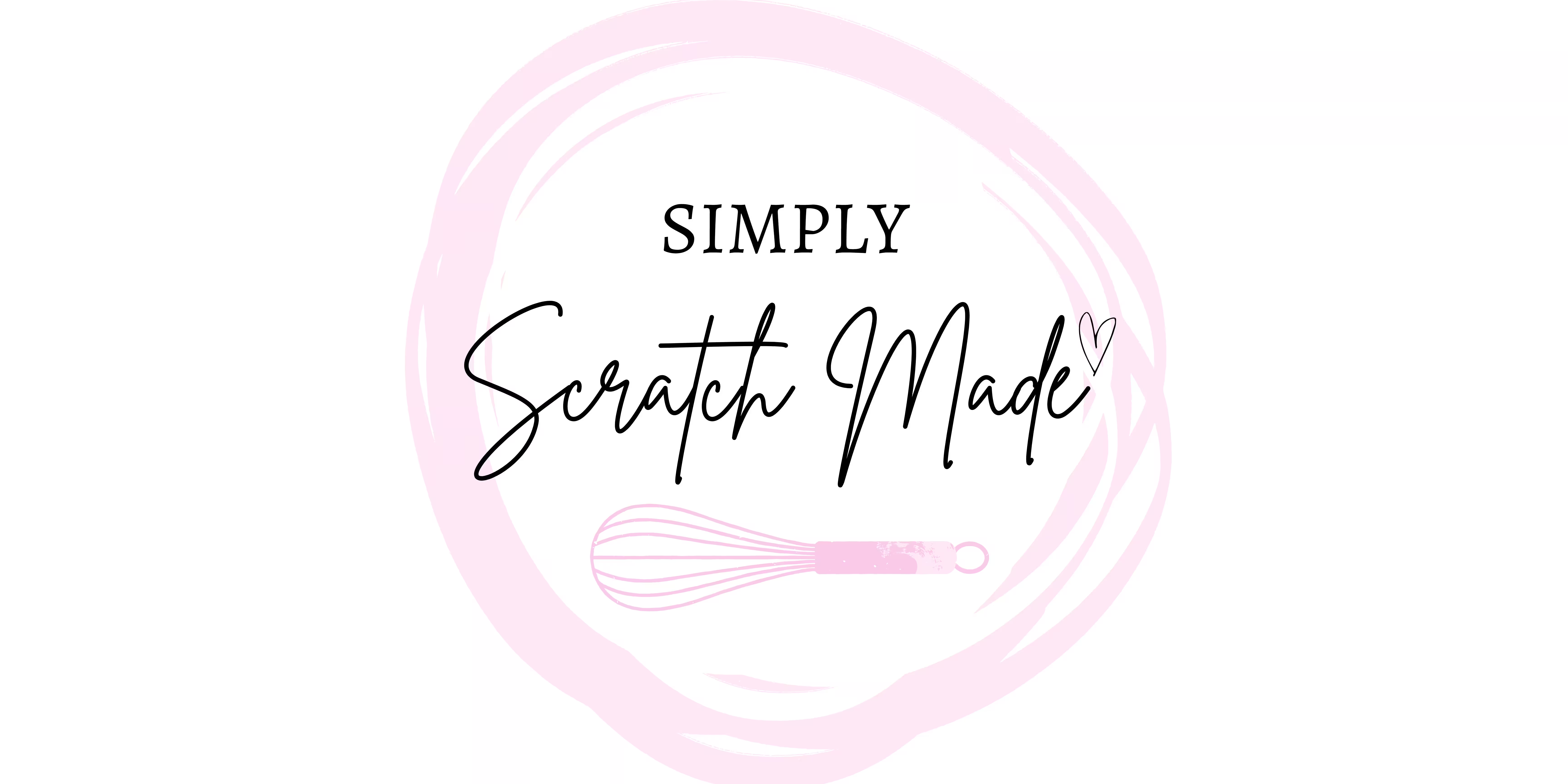
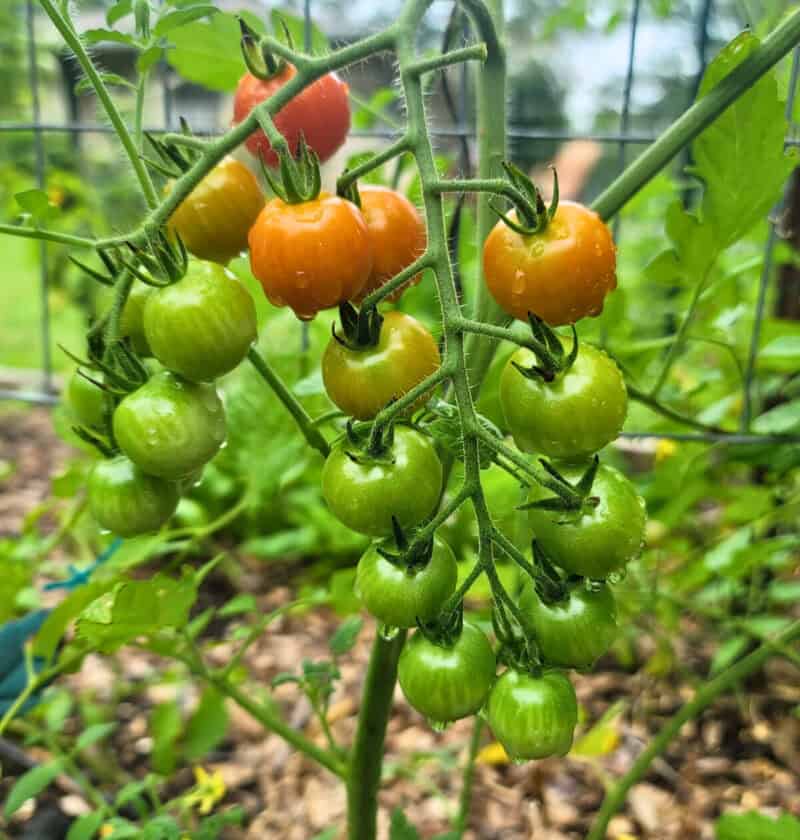
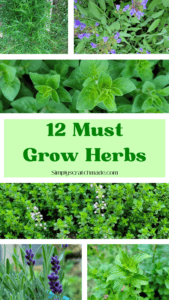
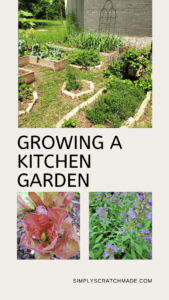
Great tips! There is nothing as tasty as fresh picked tomatoes from a garden.
I agree, fresh tomatoes from the garden are the best!
This was so helpful! I am always struggling with keeping the tomato plants thriving and these tips help so much. Can’t wait to plant this year’s crop 🙂
Thank you! I hope your tomato harvest is bountiful this year!
Love how in depth this is!! Can’t wait to get started growing more tomatoes this year!!
I’d love to get into gardening more, and these tomato tips are great! Bookmarking for this spring!
So much great information here! I can’t wait to get started on growing tomatoes 🙂
Thank you! I hope you have a great tomato year!!
So many amazing tips – thank you so much for sharing all of those. Very helpful!